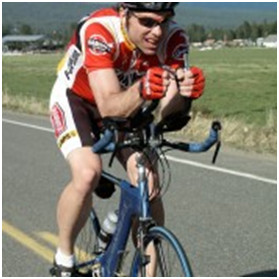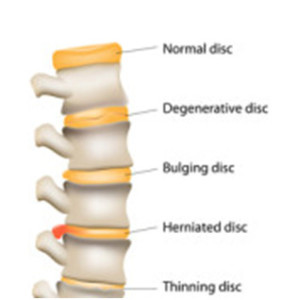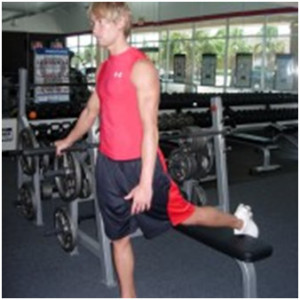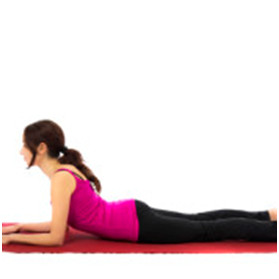Author: Julie Donnelly, LMT –The Pain Relief Expert
Editor: Dr. Steve Chaney
 This past week I taught an ultra-cyclist how to relieve a bulging disc that was causing him a great deal of pain and preventing him from riding the distances he loves.
This past week I taught an ultra-cyclist how to relieve a bulging disc that was causing him a great deal of pain and preventing him from riding the distances he loves.
The problem is aggravated by the aerodynamic position a cyclist is in while riding.
A bulging disc can happen to anyone though, especially if one sits a lot. As we sit we do the same movements, only we contract the muscles and then hold them contracted for a long period of time as we sit
What Causes A Bulging Disc?
It’s easy to see why an ultra-cyclist would have a bulging disc with the extended riding times in the bent over aerodynamic position.
In the aerodynamic position the muscle of your anterior lumbar; the psoas, is held shortened. Also, the muscle on the inside curve of your pelvis, the iliacus, shortens each time the leg is brought up toward the body when pedaling.
This position is great for riding, but when you stop and stand the tight muscles pull your lumbar vertebrae and your pelvis forward and down. At first you may walk bent over, unable to stand up straight. As your muscles relax you’ll begin to straighten, but many times it may take a while before you can fully stand upright and even then you may feel low back pain.
What Happens To The Vertebra?
 When a vertebra is pulled downward and toward the vertebra beneath it, it puts pressure on the disc between the two vertebrae. That pushes the gel-like substance inside the disc to press out the side.
When a vertebra is pulled downward and toward the vertebra beneath it, it puts pressure on the disc between the two vertebrae. That pushes the gel-like substance inside the disc to press out the side.
A good analogy is to consider what happens if you step on one side of a jelly donut — the jelly pushes out the opposite side!
A bulging disc is when the gel pushes out the side but doesn’t break the outer lining of the disc. A herniated disc is when the membrane cracks and the gel now squeezes out of the disc.
If the bulging disc, or herniated disc, presses into a nerve or your spinal curve, treatment is necessary to reverse the situation. This is definitely a time when prevention is worth a pound of cure!
A Bulging Disc Treatment and Stretch That Works!
The Treatment:
Start by releasing the tension in your thigh muscles. It sounds weird to release the muscles in your thighs to stop a bulging disc problem, but it’s important.
Using your forearm (as shown) press down deeply and slide your arm toward your knee. Place extra focus, 30-60 seconds, on each tender spot (trigger point) you feel as you slide down your thigh.
Do this treatment several times on each leg. This muscle release technique allows your pelvis to rotate back into proper position.
The Stretch:
 Stand up straight, as shown, place one of your lower legs on to a chair. Keep your body as straight as possible. Without moving your pelvis at all, lean back with your mid-back.
Stand up straight, as shown, place one of your lower legs on to a chair. Keep your body as straight as possible. Without moving your pelvis at all, lean back with your mid-back.
Visualize your abdominal muscles stretching — be sure not to move your pelvis.
You are now stretching both your psoas and iliacus muscles. Repeat stretch using other leg.
You may feel a twinge of pain in your low back as the muscles stretch and pull on your lumbar. This is normal. It should not be a sharp pain.
An Alternative Stretch:
 And as an alternative stretch, if you are able to use the floor, the Sphinx pose is a perfect stretch for the psoas and iliacus. Be sure to keep your pelvis on the floor.
And as an alternative stretch, if you are able to use the floor, the Sphinx pose is a perfect stretch for the psoas and iliacus. Be sure to keep your pelvis on the floor.
Releasing the tight muscles of your back allow your vertebrae to separate naturally. Whether you sit for hours at a time, or you ride for hours, this bulging disc treatment will give you relief and will prevent further disc injury.
Wishing you well,
Julie Donnelly
About The Author
 Julie Donnelly is a Deep Muscle Massage Therapist with 20 years of experience specializing in the treatment of chronic joint pain and sports injuries. She has worked extensively with elite athletes and patients who have been unsuccessful at finding relief through the more conventional therapies.
Julie Donnelly is a Deep Muscle Massage Therapist with 20 years of experience specializing in the treatment of chronic joint pain and sports injuries. She has worked extensively with elite athletes and patients who have been unsuccessful at finding relief through the more conventional therapies.
She has been widely published, both on – and off – line, in magazines, newsletters, and newspapers around the country. She is also often chosen to speak at national conventions, medical schools, and health facilities nationwide.
These statements have not been evaluated by the Food and Drug Administration. This information is not intended to diagnose, treat, cure or prevent any disease.
